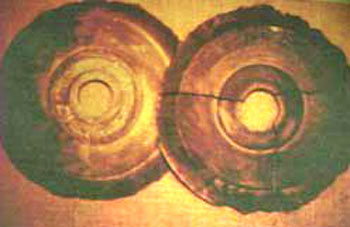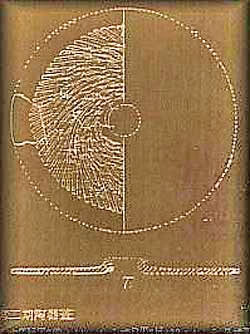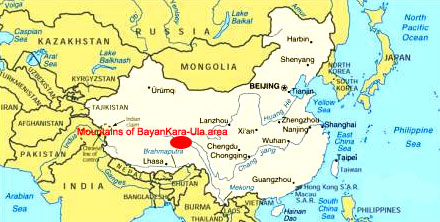|
Liber vel
Dropas Orbis
Sub-Figura vel Liber Caeruleus
by Brother Lumir G. Janku
1996
In 1938, a team of archeologists, led by
Professor Chi Pu Tei of
Beijing University, was conducting a very detailed routine survey of
a series of interlinked caves of Balan Kara-Ula, a district on the
border of China and Tibet (at the time Tibet was independent).
He and his colleagues found skeletons of small beings with delicate
frames, but with rather large skulls. At first, it had been thought
by one of the assistants that the caves had been the home of a
hitherto unknown species of ape. But as Professor Chi Pu Tei pointed
out, "Who ever heard of apes burying each other?"
On the walls of the caves were found rock drawings which portrayed
beings with round helmets. Engraved in the rock were also sun, moon,
earth and stars, connected by groups of pea-sized dots.
 It was while studying the skeletons that one of the team stumbled on
a large, round stone disk, about two centimeters thick (0.8"), half
buried in the dust on the floor of the cave. The team gathered
around the discovery, trying to make some sense of the object. It
looked, absurdly, like a sort of Stone Age gramophone record. There
was a hole in the center and a fine groove, spiralling out from the
center to the rim. It was while studying the skeletons that one of the team stumbled on
a large, round stone disk, about two centimeters thick (0.8"), half
buried in the dust on the floor of the cave. The team gathered
around the discovery, trying to make some sense of the object. It
looked, absurdly, like a sort of Stone Age gramophone record. There
was a hole in the center and a fine groove, spiralling out from the
center to the rim.
Under closer inspection, however, it was
obvious that the groove was, in fact, a continuous inscribed
double-line of closely packed characters. After a thorough search of
the caves, additional 715 plates were found. These plates were
records. Only nobody at the time was able to decipher the messages
they contained. The discs were labeled and filed away among other
finds in the area. Even those who knew of its existence knew nothing
of its meaning.
Many experts tried to translate the inscriptions in the two decades
during which the disc were stored away in Beijing, but without
success. It was not until another professor - Dr. Tsum Um Nui -
broke the code and started to decipher the speaking grooves that the
extraordinary implications of the disc were realized. Realized, that
is, only by only a select few. The outside world remained in
ignorance, for the professor's conclusions on the meaning of the
disc were so shattering that they were officially suppressed. The
Prehistory Department of the Beijing Academy forbade him to publish
his findings.
In cooperation with geologists and after spectrographic analysis, it
was found that the plates had a high cobalt and metal content (the
metals involved are not, though, referenced in the available
sources). That implied an artificial origin of the plates; they were
not of diorite as previously thought. The hardness of the material,
however, compared to diorite.
Russian scientists asked to see the discs and several were sent to
Moscow for examination. They were cleaned free of rock particles
which had stuck to them and then put through analysis which
corroborated the findings of Chinese scientists. That was not all.
When placed on a special turntable, they vibrated or hummed with a
high frequency resonance, which led to the conclusion that they had
been exposed to very high voltages at some point in time. Or as one
scientist suggested, "as if they formed some part of an electrical
circuit."

In 1963, Dr. Tsum Um Nui decided to publish the findings in spite of
the position of the Academy. The paper appeared under a long-winded
but intriguing title,
"The Grooved Script concerning Space-ships
which, as recorded on the Discs, landed on Earth 12,000 years ago".
It was not taken seriously in the West and, in short time, the whole
matter seemed to fade into oblivion. That is, until 1967, when
Russian philologist Dr. Viatcheslav Zaitsev published the extracts
from the stone-plate story in the Sputnik Magazine. Allegedly, the
whole story is preserved in the Beijing Academy, as well as in
historical archives of Taipei, R.O.C.
The deciphered records contain story which may be upsetting to some
and absurd or bizarre to others. The records told of a space probe
by the inhabitants of another planet which came to an abrupt halt in
the Bayan-Kara-Ula mountain range. The strange, spiral script told
how the peaceful intentions of theirs had been misunderstood and how
many of them were hunted down and killed by members of the Kham
tribe, who lived in the neighboring caves.
According to Tsum Um Nui, one of the lines of the hieroglyphs read,
"The Dropas came down from the
clouds in their aircraft. Our men, women and children hid in the
caves ten times before sunrise. When at last they [Kham]
understood the sign language of the Dropas, they realized that
the newcomers had peaceful intentions...".
Another section expressed regret by the
local Kham tribe that the aliens' spaceship had crash-landed in such
a remote and inaccessible mountain range and that there had been no
possibility to building a new one to enable Dropas to return to
their own planet.
In the years since the discovery of the skeletons and discs,
archeologists and anthropologists had learned more about the
isolated Bayan-Kara-Ula area.

And much of the information seemed to
corroborate the astonishing story recorded on the discs. Legend
still preserved in the area tells of small, yellow faced folks who
came from the clouds, long, long ago. These people had huge, bulging
heads and spindly bodies and were so ugly and repellent that they
were hounded down by local tribesmen. Curiously, the description of
the perceived invaders tallied with the skeletons originally
discovered in the caves by Professor Chi Pu Tei. Along with the
discs, the cave drawings and skeletons had been dated around 10,000
BCE.
At the time of discovery, the cave area was still inhabited by two
tribes known as the Khams and the Dropas, themselves extremely odd
in appearance. The frail and growth-stunted tribesmen of Dropas
averaged only about five feet in height and were neither typically
Chinese nor Tibetan.
This is where the trail ends, at the end of 60's. To my knowledge,
with an exception of paraphrasing the story by several authors, no
new elements were introduced. The story exists in a form similar to
this article, a brief summary, or sometimes as more colorful variant
but the data are the same.
Additional Information: The
Dropas
Go Back
|
 It was while studying the skeletons that one of the team stumbled on
a large, round stone disk, about two centimeters thick (0.8"), half
buried in the dust on the floor of the cave. The team gathered
around the discovery, trying to make some sense of the object. It
looked, absurdly, like a sort of Stone Age gramophone record. There
was a hole in the center and a fine groove, spiralling out from the
center to the rim.
It was while studying the skeletons that one of the team stumbled on
a large, round stone disk, about two centimeters thick (0.8"), half
buried in the dust on the floor of the cave. The team gathered
around the discovery, trying to make some sense of the object. It
looked, absurdly, like a sort of Stone Age gramophone record. There
was a hole in the center and a fine groove, spiralling out from the
center to the rim. 
